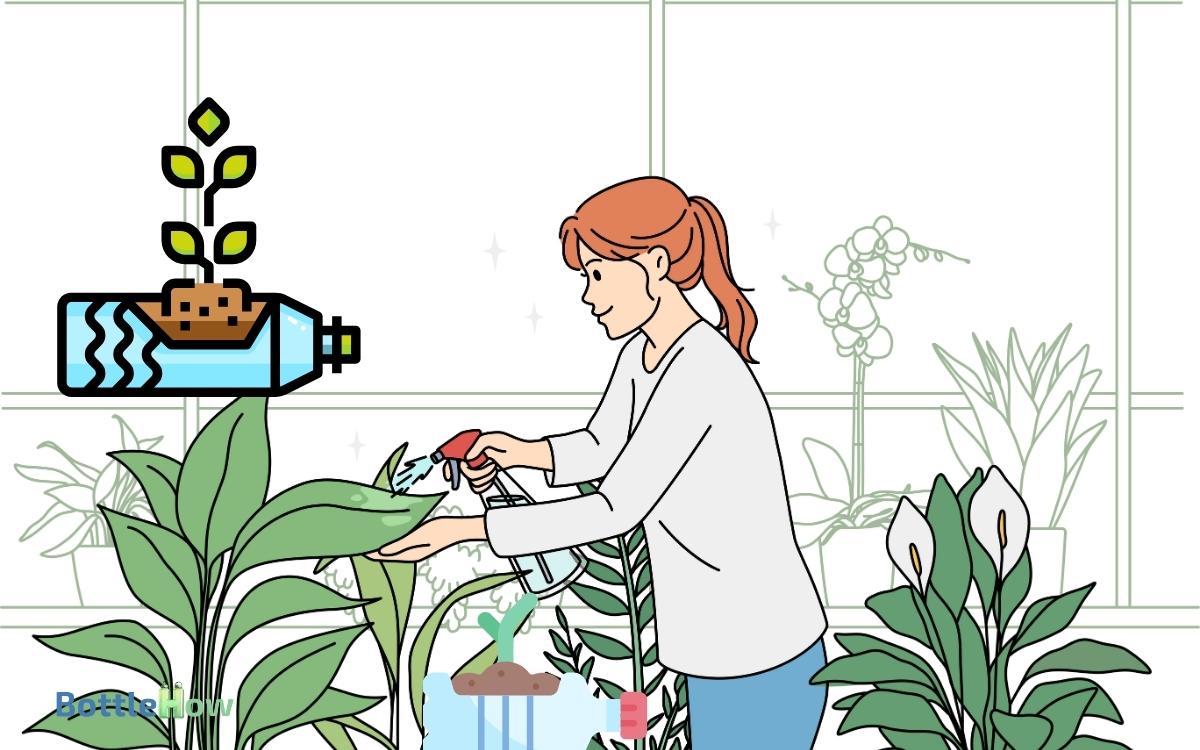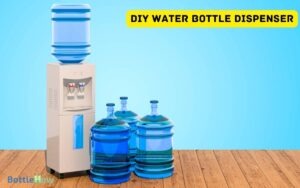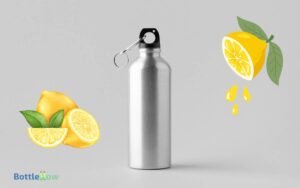Diy Water Bottle Greenhouse: Easy & Quick Guide!
Creating a DIY water bottle greenhouse is an expert blend of sustainable gardening and precise techniques.
If you follow these steps meticulously, you’ll uncover more advanced tips.

Key Takeaways
Materials Needed
To build your DIY water bottle greenhouse, gather these essential materials: a clear plastic water bottle, potting soil, seeds, a spray bottle, and a utility knife.
Start by ensuring the water bottle is thoroughly cleaned, as any residue can harbor bacteria that might harm your seedlings.
Use the utility knife to carefully cut the bottle around its circumference, creating a top and bottom section.
The potting soil should be nutrient-rich and well-draining to support ideal root development.
Select seeds suited for the micro-environment you’re creating.
The spray bottle is important for maintaining appropriate moisture levels without over-saturating the soil.
Choosing the Right Bottles
Selecting the appropriate water bottles is essential to ensuring your DIY greenhouse provides the best possible environment for your seedlings.
Opt for clear, plastic bottles as they allow maximum light penetration, vital for photosynthesis. Ideally, use bottles with a capacity of 1-2 liters; they’re large enough to create a stable microenvironment but still manageable.
Ensure the bottles are made from PET (polyethylene terephthalate) plastic, known for its durability and transparency. Avoid colored or opaque bottles, as they hinder light transmission and can disrupt plant growth.
Inspect for any cracks or imperfections that could compromise structural integrity. Clean bottles thoroughly to eliminate any residual chemicals that could be harmful to your plants.
Preparing the Bottles
Begin by washing the PET plastic bottles with a mild detergent and warm water to remove any contaminants that could harm your seedlings.
Follow these steps to guarantee ideal preparation:
- Rinse thoroughly: After washing, rinse the bottles multiple times to make sure no soap residue remains.
- Sanitize: Submerge the bottles in a solution of 1 part bleach to 9 parts water for 10 minutes to eradicate any pathogens.
- Dry completely: Allow the bottles to air dry in a clean, dust-free environment to prevent mold growth.
- Inspect for damage: Check each bottle for cracks or weak spots that could compromise the greenhouse’s structural integrity.
Proper preparation ensures a sterile, secure environment for your seedlings, promoting healthier, more robust plant growth.
Cutting and Shaping
You’ll need to select proper cutting tools like a utility knife or sharp scissors to guarantee clean cuts.
Accurately marking cut lines with a permanent marker will guide your cuts, maintaining consistency and precision.
Once cut, shaping the bottle halves correctly will facilitate ideal structural integrity and air circulation within your mini greenhouse.
Selecting Proper Tools
To cut and shape your water bottle greenhouse effectively, you’ll need a utility knife, a pair of sharp scissors, and a cutting mat for safety and precision. These tools guarantee clean, accurate cuts and minimize injury risks.
Here’s what you should have:
- Utility Knife: Essential for making precise, straight cuts. Choose one with a retractable blade for safety.
- Sharp Scissors: Ideal for cutting curved lines or intricate shapes. Ensure they’re sharp to avoid jagged edges.
- Cutting Mat: Protects your work surface and provides a stable cutting platform. Look for one with measurement grids for accuracy.
- Safety Gloves: Protect your hands from accidental nicks or cuts, especially when handling sharp tools.
Using these tools, you’ll achieve professional results in your DIY greenhouse project.
Marking Cut Lines
With your tools ready, the next step involves precisely marking the cut lines on your water bottle to guarantee accurate shaping and peak functionality of your greenhouse.
Begin by measuring the desired height from the bottle’s base, using a ruler for precision. Mark this point with a permanent marker.
For even cutting, wrap a piece of masking tape around the bottle at this height, creating a uniform guide. Make sure your line is straight to avoid an uneven cut, which can compromise structural integrity.
If your design includes ventilation holes, mark their locations evenly spaced around the bottle. Using precise measurements and clear markings ensures your greenhouse will provide ideal conditions for plant growth, maximizing light entry and maintaining a stable microenvironment.
Shaping Bottle Halves
After marking your cut lines, carefully use a sharp utility knife or pair of sturdy scissors to slice through the plastic, ensuring a clean and precise separation of the bottle halves.
To achieve best shaping, follow these steps:
- Stabilize the Bottle: Place the bottle on a firm surface to prevent slipping.
- Cut Slowly: Apply consistent pressure to avoid jagged edges.
- Smooth Edges: Use fine-grit sandpaper to eliminate sharp or uneven areas.
- Test Fit: Align the halves to make sure they fit together without gaps.
Assembling the Structure
First, gather all your pre-cut water bottles, sturdy sticks, and zip ties to make sure you have everything on hand.
Next, construct the framework by securing the sticks into the ground and connecting them with horizontal supports using zip ties.
This creates a stable skeleton to which you’ll attach the water bottles, forming the walls and roof of your greenhouse.
Preparing Materials Needed
Gather the essential materials to begin constructing your DIY greenhouse:
- Clean Plastic Water Bottle: Select a transparent bottle to maximize light penetration.
- Potting Soil: Choose a high-quality, well-draining mix rich in organic matter.
- Seeds: Opt for seeds that thrive in controlled mini-greenhouse conditions, like herbs or small vegetables.
- Scissors: Use sharp, clean scissors to make precise cuts without damaging the plastic.
Confirm each item is readily available and in excellent condition.
Building the Framework
Using your sharp scissors, carefully cut the water bottle in half to create the two main sections of your greenhouse: the base and the lid.
The base will serve as the container holding the soil and seedlings, while the lid acts as a protective dome. Make sure the cut is clean and even to facilitate a snug fit.
Next, create ventilation holes in the lid by puncturing small, evenly spaced holes using a heated nail or similar tool. This step is essential for maintaining ideal humidity and air circulation.
Securing the Greenhouse
Securing your DIY water bottle greenhouse is crucial to protect your plants from environmental stressors like wind and heavy rain.
To achieve a stable structure, follow these steps:
- Ground Anchors: Use metal or plastic ground anchors to firmly attach the base of your greenhouse to the soil. This guarantees stability against strong winds.
- Tension Cables: Install tension cables diagonally across the interior. These add structural integrity and minimize sway.
- Weight Distribution: Distribute weights, such as sandbags, around the base. This prevents the greenhouse from lifting during storms.
- Reinforced Joints: Apply waterproof adhesive or sealant at all joint connections. This not only strengthens the structure but also prevents water seepage.
Ventilation Tips
Proper ventilation in your DIY water bottle greenhouse is essential to regulate temperature, humidity, and carbon dioxide levels, ensuring ideal plant growth.
To achieve this, you should create small, strategically placed vents. Poke holes near the top of the water bottle to allow hot air to escape, preventing overheating. This simple modification improves airflow and helps regulate the temperature more effectively. By allowing heat to dissipate gradually, your DIY hot water bottle remains warm for longer without becoming too hot to handle. Additionally, ensuring proper vent placement enhances comfort and safety while using it.
Additionally, make small openings at the base to facilitate fresh air intake, which will enhance photosynthesis by supplying necessary CO2.
Remember to monitor the greenhouse daily; if condensation builds up excessively, increase the number or size of the vents. Employing a hygrometer can help you maintain the best humidity levels.
Placing Your Greenhouse
When placing your DIY water bottle greenhouse, always consider factors like sunlight exposure, protection from strong winds, and proximity to a water source. Ideal placement guarantees your plants thrive.
Here are key considerations:
- Sunlight Exposure: Position your greenhouse to receive at least six hours of direct sunlight daily. This maximizes photosynthesis and plant growth.
- Wind Protection: Locate your greenhouse in an area shielded from strong winds to prevent structural damage and maintain a stable internal temperature.
- Water Source: Place your greenhouse near a water source to facilitate easy irrigation and reduce plant stress.
- Soil Quality: Ensure the ground beneath your greenhouse has fertile, well-draining soil to promote healthy root development.
Planting Inside
Begin planting inside your DIY water bottle greenhouse by selecting appropriate soil and seeds tailored to the microenvironment you’ve created.
Opt for a high-quality potting mix, rich in organic matter, to guarantee ideal root development and nutrient availability.
Consider using seeds suited for confined spaces and high humidity, such as herbs, leafy greens, or small flowering plants.
Moisten the soil before planting to make certain of even hydration. Plant seeds at the recommended depth, typically twice the seed’s diameter, and lightly cover them with soil. Gently press down to establish good soil-to-seed contact.
Place the water bottle greenhouse in a location with adequate light, ensuring about 6-8 hours of indirect sunlight daily. Monitor initial germination closely to adjust conditions if necessary.
Maintenance and Care
To guarantee maximum growth within your DIY water bottle greenhouse, regularly monitor moisture levels and adjust watering frequency based on the plant’s specific needs. Maintain ideal conditions by keeping consistent humidity and temperature.
Here are key maintenance steps:
- Check Moisture: Use a soil moisture meter to make sure soil stays evenly moist but not waterlogged.
- Light Exposure: Position your greenhouse in a location that receives sufficient sunlight, typically 6-8 hours daily.
- Ventilation: Open the bottle cap periodically to allow air circulation, preventing mold and mildew.
- Pruning: Trim any dead or yellowing leaves to encourage healthy growth and prevent disease.
Conclusion
By repurposing plastic bottles, you’re not just creating a greenhouse; you’re also reducing waste.
Did you know that the average American uses about 13 plastic bottles per month? Imagine the environmental impact if more people turned those into greenhouses!
With proper ventilation, strategic placement, and regular maintenance, your DIY bottle greenhouse will thrive, offering an eco-friendly solution to growing plants.
Embrace this innovative approach and watch your garden flourish sustainably.




